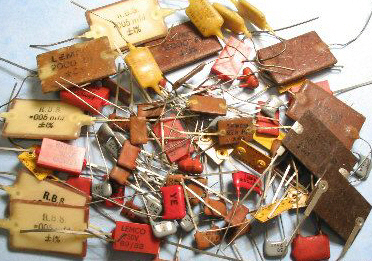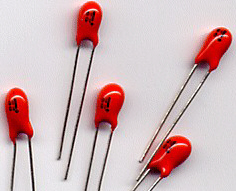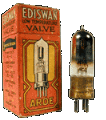Peter Lankshear, Invercargill, New Zealand. photos coming soon...
[
Safety
|
Basics
|
Transformers
|
Speakers
|
Coils IF & RF
|
Capacitors
|
Resistors
& Pots |
Valves
]
Also check our capactitor data pages
out
 Capacitors - The most numerous components in
valve-equipped receivers are capacitors, which, because of their number
and nature, are likely to have the highest incidence of failures. To
compound the problem, there is a big variety of types, each with
different characteristics.
Any two conductors separated by an insulator, including air or a vacuum,
will form a capacitor, and it is the failure of this insulator, known as
a dielectric, or the connection to the conductors, that makes a
capacitor unserviceable.
It is the nature of their dielectrics that categorize capacitors and
governs their characteristics. Some types are interchangeable; others
are most definitely not. To add to the confusion, towards the end of the
period when valve receivers were made, there was a revolution in
capacitor manufacturing with the two most common types, paper and mica
being largely superseded by modern types with better reliability and
performance.
Capacitors - The most numerous components in
valve-equipped receivers are capacitors, which, because of their number
and nature, are likely to have the highest incidence of failures. To
compound the problem, there is a big variety of types, each with
different characteristics.
Any two conductors separated by an insulator, including air or a vacuum,
will form a capacitor, and it is the failure of this insulator, known as
a dielectric, or the connection to the conductors, that makes a
capacitor unserviceable.
It is the nature of their dielectrics that categorize capacitors and
governs their characteristics. Some types are interchangeable; others
are most definitely not. To add to the confusion, towards the end of the
period when valve receivers were made, there was a revolution in
capacitor manufacturing with the two most common types, paper and mica
being largely superseded by modern types with better reliability and
performance.
|
TYPES OF CAPACITOR FOUND IN VALVE RADIOS |
|
TYPE |
DETAILS |
COMMENTS |
|
Paper |
The most common
type found in receivers built before about 1960. |
Superseded by
plastic dielectric types. Now rarely used. |
|
Mica |
Excellent
characteristics. Used in critical locations. |
Replaced largely
by ceramic and polystyrene types. |
|
Aluminium
Electrolytic |
High capacitance
and leakage resistance. Standard for H.T. filtering and audio
cathode bypass. |
Modern units are
very small and reliable. |
|
Ceramic |
Have replaced mica
types. Efficient. |
Very compact and
large variety. Some types unsuitable for tuned circuits. |
|
Polyester |
Alternative to
paper caps after late 1950ís. |
Very reliable,
compact and efficient. |
|
Polystyrene |
Excellent
temperature stability. |
Used mainly in
tuned circuits. |
PAPER CAPACITORS
Until about 1960, these were the most common with a range of 1.0 mfd or
more down to .001 mfd and consist of two strips of foil separated by
layers of thin paper, impregnated with wax or oil. Instead of foil, some
had an extremely thin layer of metal deposited on the paper and were
known as metallised capacitors.
This construction saved space and rendered the capacitor self-healing in
the event of a breakdown, with the metal deposit vapourising around the
trouble spot. One synthetic impregnating material used in paper
capacitors, PCB, has excellent dielectric characteristics but has been
outlawed because it is practically indestructible and can enter the food
chain. Be suspicious of metal cased capacitors that leak a clear viscous
impregnant. A good paper capacitor will have a resistance measurement of
several hundred megohms, but as they were extremely difficult to seal
against eventual moisture absorption, many are likely to now measure
much less, especially those with cardboard cases. Metal and plastic
cased components were used with varying degrees of success. Generally
the metal cased type will be found to have survived reasonably well, but
there have been some criticisms of plastic cases. In spite of their
apparently excellent encapsulation, there are many reports of their
failure. Others to watch for are those with thin grey coloured moulded
cases, which can develop hairline cracks, which will let in moisture.
These were popular at one time as replacements, and if you find any with
cracks, don't even bother to test them.
Paper capacitors used for protracted periods on high voltage develop a
"memory" and when disconnected can generate appreciable voltages
upsetting attempts to measure their insulation resistance. This produces
a different reading when the meter leads are reversed. They were used
mainly for R.F. bypassing in HT lines, screen and R.F. and I.F. cathode
bypassing, and for providing the time constant and bypassing of
automatic gain control lines. The amount of leakage that is acceptable
depends on the location. A common application was for bypassing cathode
bias resistors of only a few hundred ohms. Clearly in this instance, a
capacitor with leakage resistance of a megohm is not much of a problem,
but the same capacitor in an automatic gain control line could degrade
the A.G.C. performance quite seriously.
Another critical location for paper capacitors is the coupling capacitor
between audio stages, commonly used in domestic receivers. Leakage here
will upset the grid bias of the driven valve and has often been the
cause of overloading and short life of the output valve(s). Later models
often used ceramic audio coupling capacitors to avoid this problem.
Early in the 1960's many manufacturers abandoned paper capacitors and
changed over to buff coloured plastic coated Philips polyesters. These
have proved to be excellent in service and rarely need replacing.
MICA CAPACITORS
 Along with paper and glass, mica is one of the "historic" 19th Century
dielectrics and was the best available in terms of low leakage, low
losses (power factor), stability and long life. They were made with both
foil and metallised types, the latter being known as "silvered mica".
They were frequently used for tuned circuits and as small R.F. coupling
and bypassing capacitors. Along with paper and glass, mica is one of the "historic" 19th Century
dielectrics and was the best available in terms of low leakage, low
losses (power factor), stability and long life. They were made with both
foil and metallised types, the latter being known as "silvered mica".
They were frequently used for tuned circuits and as small R.F. coupling
and bypassing capacitors.
By the nature of mica, they have to be built up in a stack, making them
easily recognized in having a rectangular form, usually having Bakelite
cases and are never tubular. They are sometimes very thin and wax
coated. Mica capacitors are a bit like the little girl in the nursery
jingle - when they are good they are very very good, but when they are
bad they are a disaster! A faulty paper capacitor can be a bit leaky but
a mica capacitor is more likely to develop a dead short. The reason for
this is interesting. Under an electrical stress, metal from the
electrodes can actually migrate through apparently solid mica, forming
microscopic "trees" or dendrites, often only of molecular thickness.
When two dendrites meet, they link up and a short circuit results.
Another unfortunate habit is developing an intermittent loss of some
capacitance, probably due to disconnected foils. This can be very
confusing if the capacitor is part of a tuned circuit.Although they are sometimes still available, many suppliers no longer
stock mica capacitors. Polystyrene or suitable ceramic types of adequate
voltage rating can replace them.
ELECTROLYTIC CAPACITORS For the past 75 years, electrolytic capacitors,
which evolved from electrolytic rectifiers and combine large capacitance
with small size, have been an indispensable component in receivers.
Before their advent, power supply filtering capacitors were very bulky
and expensive and audio cathode bypassing was frequently inadequate.
Their dielectric is a thin coating of aluminium oxide on the positive
electrode, created by electrolytic action, and they must of course, be
connected with the correct polarity to maintain the dielectric. The
earliest electrolytic capacitors were liquid filled, but so far as I am
aware, were not used in post War models.
The familiar so-called dry electrolytics still need a liquid, but as in
"dry cell" batteries this is in the form of a paste. Manufacturers have
had remarkable success in sealing these capacitors against evaporation,
especially with chassis mounted types. The writer has several receivers
still with the original 40 + year old filter capacitors working well. In
fact it is quite common to find electrolytics that have outlasted their
paper contemporaries. Signs to watch for are increased hum levels or
bulging fibre ends. To check out filters is easy, simply bridge the
suspect capacitor with a known good one and note if there is a change in
the hum level.
TANTALUM CAPACITORS
 Tantalum capacitors can be regarded as electrolytics with superior
characteristics. They are smaller and have lower leakage than
electrolytics, but are available in low voltage ratings only. To the
best of my knowledge they were not used in valved receivers and there is
no real need for restorers to use them. Tantalum capacitors can be regarded as electrolytics with superior
characteristics. They are smaller and have lower leakage than
electrolytics, but are available in low voltage ratings only. To the
best of my knowledge they were not used in valved receivers and there is
no real need for restorers to use them.
THE POLY FAMILY
Replace paper types with plastic dielectrics, and provided they are
worked within their voltage rating, the chances are that they will
outlast you! There are several types of plastic dielectric capacitors
all with names starting with "Poly". As with paper capacitors, both foil
and metallized construction is used but they are smaller than their
paper equivalents. Make sure that, in valve circuits, replacement
capacitors have an adequate voltage rating.
Modem equipment generally operates with low voltages, and capacitor
ratings reflect this, with working voltages of 5Ov or 1OOv, but
capacitors used for valve circuits, especially if they had any
association with the receiver high tension, had ratings upwards of 250
volts. Fortunately 400vw and 630vw polyesters are still in the
catalogues and should be used, especially for HT and screen bypasses.
Capacitors with axial leads are to be preferred, as, although physically
smaller than equivalent paper varieties, they will fit readily in the
original wiring and layout. However, radial lead polyesters, intended
for printed circuit boards are more commonly available and their small
size makes them an easy fit. Their appearance may not be as appropriate
as axial lead types.
|
PLASTIC
DIELECTRIC CAPACITORS |
|
Type &
Construction |
Characteristics |
|
Polyester, foil and metallised. |
General purpose
and can be used as an excellent substitute for any paper
capacitors. |
|
Polycarbonate, foil and metallised. |
Their capacitance
varies less with temperature than does polyesters, but are prone
to moisture absorption. Probably not applicable for valve
receivers. |
|
Polypropylene, metallised. |
Low loss used for
mains applications and some power supplies. Normally not
warranted in receivers. |
|
Polystyrene, foil. |
Probably the
earliest plastic capacitors. Generally tubular and often encased
in clear plastic. Bigger than equivalent polyesters they have
excellent temperature characteristics. Chief use was in tuned
circuits, especially I.F.Transformers |
CERAMIC CAPACITORS
 There is a greater variety ceramic types than any other species of
capacitor. One supplier's site found on the Internet lists over 100
different types! Not only do these have different characteristics, but
also many have specialist uses. The two major categories used by later
model receivers are general purpose and precision. General Purpose
ceramics are not intended for critical applications but are suitable for
use as bypass, filter and non-critical coupling elements in high
frequency circuits where changes in capacitance caused by temperature
variations are not critical. There is a greater variety ceramic types than any other species of
capacitor. One supplier's site found on the Internet lists over 100
different types! Not only do these have different characteristics, but
also many have specialist uses. The two major categories used by later
model receivers are general purpose and precision. General Purpose
ceramics are not intended for critical applications but are suitable for
use as bypass, filter and non-critical coupling elements in high
frequency circuits where changes in capacitance caused by temperature
variations are not critical.
General Purpose types are sometimes called Hi K and although they make
excellent coupling and bypass capacitors, they are quite unsuitable for
tuned circuits. Capacitance tolerance is wide, frequently as much as 20%
and they can be in the several forms, including tubes plates and discs.
Close tolerance Ceramics will often have markings such as NPO-1% and are
larger than the equivalent general types and are used mainly in tuned
circuits. They are normally made in values below a few hundred mmf, but
their markings are often m1nimal and it can be difficult to
differentiate them from general-purpose types. Unless you are absolutely
certain about a ceramic capacitor's specification, use polystyrene
replacements in critical locations.
 |
 Main
Menu[
Home |
©redits
|
Search
| Promote
|
Links
|
Guest
Book |
What's New?
]
Main
Menu[
Home |
©redits
|
Search
| Promote
|
Links
|
Guest
Book |
What's New?
]

 Capacitors - The most numerous components in
valve-equipped receivers are capacitors, which, because of their number
and nature, are likely to have the highest incidence of failures. To
compound the problem, there is a big variety of types, each with
different characteristics.
Any two conductors separated by an insulator, including air or a vacuum,
will form a capacitor, and it is the failure of this insulator, known as
a dielectric, or the connection to the conductors, that makes a
capacitor unserviceable.
It is the nature of their dielectrics that categorize capacitors and
governs their characteristics. Some types are interchangeable; others
are most definitely not. To add to the confusion, towards the end of the
period when valve receivers were made, there was a revolution in
capacitor manufacturing with the two most common types, paper and mica
being largely superseded by modern types with better reliability and
performance.
Capacitors - The most numerous components in
valve-equipped receivers are capacitors, which, because of their number
and nature, are likely to have the highest incidence of failures. To
compound the problem, there is a big variety of types, each with
different characteristics.
Any two conductors separated by an insulator, including air or a vacuum,
will form a capacitor, and it is the failure of this insulator, known as
a dielectric, or the connection to the conductors, that makes a
capacitor unserviceable.
It is the nature of their dielectrics that categorize capacitors and
governs their characteristics. Some types are interchangeable; others
are most definitely not. To add to the confusion, towards the end of the
period when valve receivers were made, there was a revolution in
capacitor manufacturing with the two most common types, paper and mica
being largely superseded by modern types with better reliability and
performance. Along with paper and glass, mica is one of the "historic" 19th Century
dielectrics and was the best available in terms of low leakage, low
losses (power factor), stability and long life. They were made with both
foil and metallised types, the latter being known as "silvered mica".
They were frequently used for tuned circuits and as small R.F. coupling
and bypassing capacitors.
Along with paper and glass, mica is one of the "historic" 19th Century
dielectrics and was the best available in terms of low leakage, low
losses (power factor), stability and long life. They were made with both
foil and metallised types, the latter being known as "silvered mica".
They were frequently used for tuned circuits and as small R.F. coupling
and bypassing capacitors. Tantalum capacitors can be regarded as electrolytics with superior
characteristics. They are smaller and have lower leakage than
electrolytics, but are available in low voltage ratings only. To the
best of my knowledge they were not used in valved receivers and there is
no real need for restorers to use them.
Tantalum capacitors can be regarded as electrolytics with superior
characteristics. They are smaller and have lower leakage than
electrolytics, but are available in low voltage ratings only. To the
best of my knowledge they were not used in valved receivers and there is
no real need for restorers to use them. There is a greater variety ceramic types than any other species of
capacitor. One supplier's site found on the Internet lists over 100
different types! Not only do these have different characteristics, but
also many have specialist uses. The two major categories used by later
model receivers are general purpose and precision. General Purpose
ceramics are not intended for critical applications but are suitable for
use as bypass, filter and non-critical coupling elements in high
frequency circuits where changes in capacitance caused by temperature
variations are not critical.
There is a greater variety ceramic types than any other species of
capacitor. One supplier's site found on the Internet lists over 100
different types! Not only do these have different characteristics, but
also many have specialist uses. The two major categories used by later
model receivers are general purpose and precision. General Purpose
ceramics are not intended for critical applications but are suitable for
use as bypass, filter and non-critical coupling elements in high
frequency circuits where changes in capacitance caused by temperature
variations are not critical.









